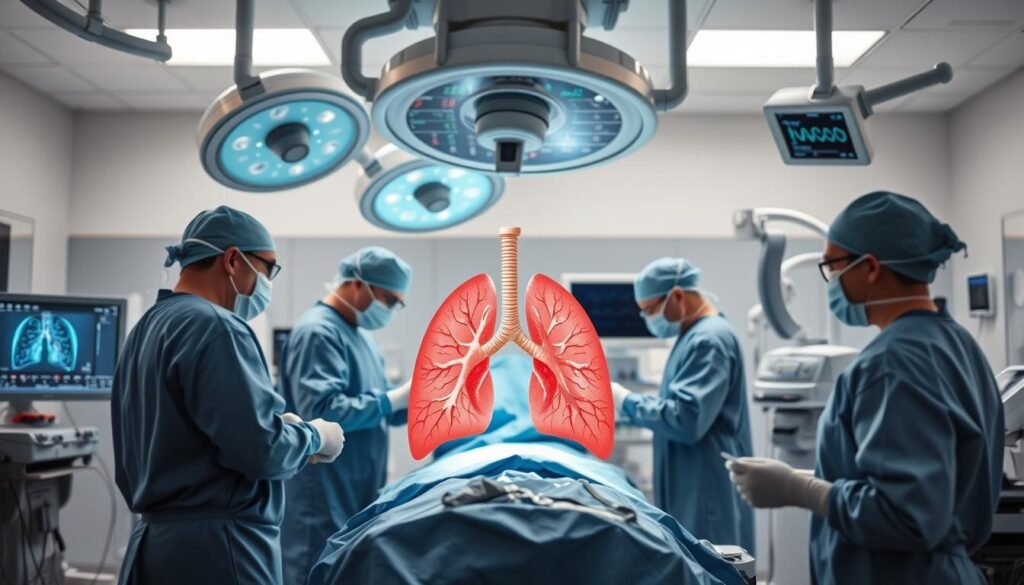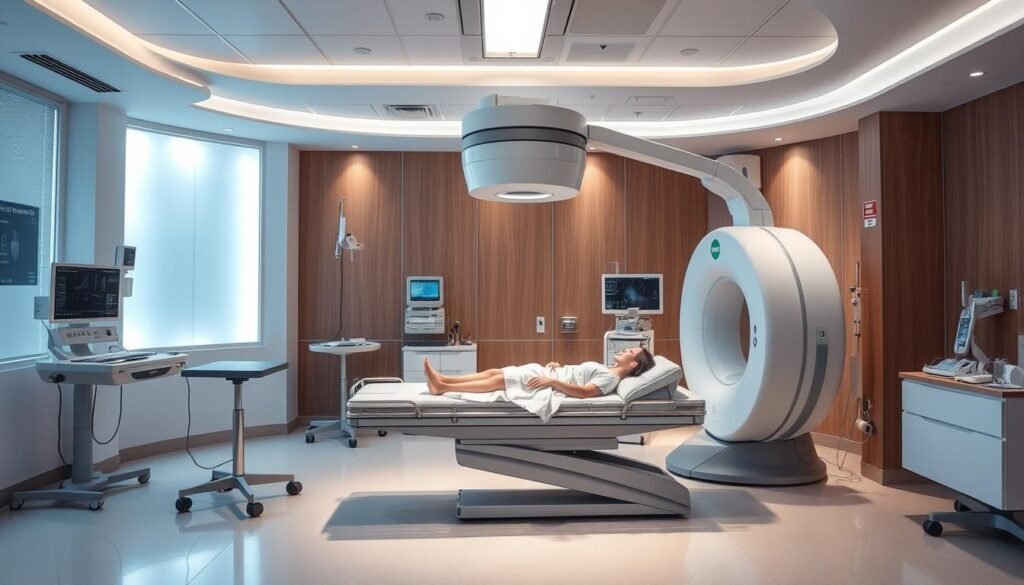Did you know lung cancer screening is for those 50 and older who smoked a lot? This fact highlights the urgent need for awareness. Lung cancer leads to many deaths in the United States. Knowing all about lung cancer treatment is key for quick diagnosis and effective care.
This guide looks at all the ways to treat lung cancer. It stresses that treatments should match each patient’s special needs. Options range from surgery to the latest in immunotherapy. The choice depends on the cancer stage, patient health, and personal choices.
As we dive into this guide, you’ll learn about the specific treatments for lung cancer. Knowing these options helps patients and their families. It encourages teaming up for the best care. This makes everyone informed and supported in fighting this tough disease.
Key Takeaways
- Lung cancer screening is targeted at those 50 and older with a heavy smoking history.
- Individualized lung cancer treatment plans are crucial for optimal care.
- Surgical options depend on tumor size, location, and overall patient health.
- Combination therapies, including chemotherapy and radiation, are commonly used.
- Immunotherapy represents a promising novel approach in lung cancer treatment.
Understanding Lung Cancer and Its Types
Lung cancer is a major health issue, split into two main types: small cell lung cancer (SCLC) and non-small cell lung cancer (NSCLC). NSCLC makes up about 80% to 85% of all cases, making it more common. Understanding these types is key to choosing the right treatment.
NSCLC includes subtypes like adenocarcinoma, squamous cell carcinoma, and large cell carcinoma. Adenocarcinoma is often seen in women and is the most common type in the U.S. Smoking is closely linked to squamous cell carcinoma. Large cell carcinoma grows fast, making treatment challenging.
Small cell lung cancer makes up 10% to 15% of lung cancers. It grows and spreads quickly, usually needing aggressive treatment. Treatment often combines chemotherapy and radiation because of its fast spread.
Genetic testing is now a crucial part of cancer care. It helps create personalized treatment plans based on genetic changes. Early detection through screening greatly improves chances of successful treatment.
New treatments are being found through clinical trials. Techniques like acupuncture or dietary supplements can help ease symptoms. They are used along with main treatments to support patients.
Common Symptoms and Risk Factors of Lung Cancer
Being aware of lung cancer symptoms is vital for early treatment. Common signs include:
- Persistent cough that does not go away
- Chest pain that worsens with deep breathing, coughing, or laughing
- Unexplained weight loss
- Coughing up blood or rust-colored sputum
Symptoms usually show up in the later stages. This makes early diagnosis hard. Recognizing signs early can improve treatment outcomes.
Knowing what increases your lung cancer risk is key for prevention. Tobacco is the main cause, linked to 80% of deaths. Secondhand smoke is also a leading risk in the US. Other major risks include:
- Radon exposure: The US Environmental Protection Agency lists it as the second-leading cause.
- Asbestos exposure: Some workers are more prone, especially if they smoke.
- Radiation therapy: Past chest treatments for cancer can increase risk.
- Family history: Genetic factors can make some people more susceptible.
- Outdoor air pollution: Plays a small role but still impacts lung cancer rates in the US.
To prevent lung cancer, quit smoking and avoid harmful substances. Regular health screenings can also help detect it early.
| Risk Factor | Details |
|---|---|
| Tobacco Use | Responsible for 80% of lung cancer deaths |
| Secondhand Smoke | Third most common cause in the U.S. |
| Radon Exposure | Second-leading cause of lung cancer |
| Asbestos Exposure | Increased risk for workers in specific industries |
| Family History | Higher likelihood of developing lung cancer |
| Outdoor Air Pollution | Accounts for 1% to 2% of lung cancer deaths |
Diagnosis of Lung Cancer
To diagnose lung cancer, doctors use imaging tests that show issues in the lungs. These methods help find where and how big tumors might be. This is the first step towards deciding on tests and treatments.
Imaging Tests for Lung Cancer
Doctors often use X-rays, CT scans, and PET scans to look for lung cancer. X-rays give a quick overview. CT scans show the lung in detail. These tests are key in checking your lungs and planning what to do next.
Biopsy Procedures
To confirm lung cancer, a biopsy is done. This means taking small pieces of lung tissue to look at under a microscope. Here are some ways to do it:
- Bronchoscopy: This lets doctors see inside the lungs directly.
- Needle Biopsies: Doctors use imaging to guide the needle for precise sampling.
Getting the right tissue samples is very important. It helps diagnose the cancer and understand its type and severity.
Staging of Lung Cancer
Figuring out the stage of lung cancer is critical. It shows how much the cancer has spread. This decides the treatment plan. Staging goes from 0 (still in place) to 4 (spread far). MRI and CT scans can show if lymph nodes are involved or if the cancer has spread to other parts.
For more about lung cancer diagnosis, check this informative resource.
Treatment Options for Lung Cancer
Choosing treatment for lung cancer combines surgery and other methods, based on patient needs. In early stages, surgery might be possible. For advanced lung cancer, non-surgical treatments may be better.
Surgical Options for Lung Cancer
Early-stage lung cancer often leads to surgery. There are different surgical options for lung cancer, such as:
- Wedge resection: A small lung section with the tumor is removed.
- Segmental resection: A larger lung portion is taken out.
- Lobectomy: An entire lobe of the lung is removed.
- Pneumonectomy: One lung is entirely removed.
The surgery type depends on the tumor’s size and location, also on patient health. After surgery, recovery is crucial for improving survival rates. These rates vary by disease stage.
Non-Surgical Treatments for Lung Cancer
If surgery isn’t suitable, non-surgical treatments for lung cancer are crucial. They include:
- Chemotherapy: This approach uses drugs to lessen tumors. It’s given in cycles to be effective and limit side effects.
- Radiation therapy: High-energy rays target and destroy cancer cells. It’s key for half of lung cancer patients, sometimes with other treatments.
Using different treatments together can improve results. Chemotherapy, for example, can raise survival chances by 5-10%. For more details on lung cancer treatments, check MD Anderson’s lung cancer treatment page.

Chemotherapy for Lung Cancer
Chemotherapy for lung cancer uses strong drugs to fight cancer cells. It’s key for treating non-small cell lung cancer (NSCLC) at various stages. Learning how it works helps us see its value in fighting lung cancer.
How Chemotherapy Works
Chemotherapy drugs stop cancer cells from growing and spreading. They can be given through an IV or as pills. Drugs like cisplatin and carboplatin are often used together to treat lung cancer effectively.
These treatments are given in cycles that last three to four weeks. This schedule allows patients to recover between sessions. Side effects can include hair loss, a higher risk of infection, and tiredness. But these differ from person to person and depend on the drugs used.
Typical Chemotherapy Regimens
For lung cancer treatment, doctors usually combine two drugs to make the therapy stronger. If a patient can’t handle two drugs, they might get just one, especially in advanced stages. Treatment often lasts three to four months. Advanced lung cancer treatment can go for four to six cycles. It may be followed by maintenance therapy if the cancer responds well.
Learning about the latest treatments for lung cancer helps patients and doctors make better decisions. It’s important to stay updated on new options for chemotherapy.
Radiation Therapy for Lung Cancer
Radiation therapy is key in treating lung cancer. It kills cancer cells with high-energy rays, like X-rays. Lung cancer has two main radiation therapies: external beam therapy and stereotactic body radiotherapy. These approaches are chosen based on the tumor’s stage and location.
Types of Radiation Therapy
External beam radiation therapy (EBRT) is widely used for lung cancer. It’s given five times a week, over five to seven weeks. This method targets cancer effectively, sparing healthy tissues. Stereotactic body radiation therapy (SBRT) offers high doses in one to five sessions. It precisely hits tumors, minimizing harm to surrounding healthy tissues.
Other techniques include:
- Brachytherapy: An internal method, often providing symptom relief for certain lung cancer patients.
- Proton therapy: This targets tumors with protons, not X-rays. It’s great for Stage III lung cancer, reducing damage to nearby organs.
When Radiation Therapy is Used
Radiation therapy varies in its use for lung cancer treatments. It might shrink tumors before surgery or destroy remaining cancer cells afterwards. For small cell lung cancer (SCLC), it can help prevent brain spread. It also eases symptoms in late-stage diseases.
Some side effects of lung cancer radiation therapy are:
- Fatigue
- Nausea
- Skin changes
- Cough
- Painful swallowing
These effects usually go away within two months after the therapy. However, some late side effects can appear. Discussing the benefits and risks of radiation therapy with healthcare providers is crucial.

| Type of Radiation Therapy | Advantages | Typical Sessions |
|---|---|---|
| External Beam Radiation Therapy (EBRT) | Commonly used, minimizes damage to healthy tissue | 5 days per week for 5 to 7 weeks |
| Stereotactic Body Radiation Therapy (SBRT) | High doses, fewer treatments, precise targeting | 1 to 5 sessions |
| Brachytherapy | Internal treatment, alleviates airway symptoms | Varies based on individual treatment plans |
| Proton Therapy | Lower damage to surrounding tissues, effective for Stage III cases | Individualized treatment plans |
Targeted Therapy for Lung Cancer
Targeted therapy is a big step forward in cancer treatment. It uses drugs to target cancer cells’ unique features. This method works well for some lung cancers, where gene changes affect the cancer’s growth.
What is Targeted Therapy?
Targeted therapy looks to fight the DNA changes in cancer cells that cause them to grow wildly. Unlike chemotherapy, which impacts all quickly growing cells, targeted therapy goes after specific cancer markers. This focus often means patients face fewer side effects and enjoy a better quality of life while being treated.
There are many types of targeted therapies for lung cancer. These include:
- Tyrosine kinase inhibitors
- Antibody-drug conjugates (ADCs)
- Angiogenesis inhibitors
Some targeted therapies work on mutations like EGFR, ALK, ROS1, and BRAF V600E. They block cancer cell growth paths while not harming normal cells. This approach has changed how we treat cancer for the better.
Eligibility for Targeted Therapy
Figuring out if someone can get targeted therapy means testing their tumor genetically. This reveals specific mutations that help choose the right treatment. Only a small percentage of lung cancers have the ALK gene change, often in younger people and those who never smoked. Around 1% to 2% of these cancers have ROS1 mutations, making testing vital.
Next-generation sequencing (NGS) is a cutting-edge test. It screens for many mutations at once, offering a detailed look at a patient’s cancer. Anyone with lung cancer should talk to their doctor about this test. It’s key for finding the best way to treat their cancer.
In summary, targeted therapy attacks cancer cells directly, allowing for personalized treatment based on genetics. This approach leads to better results and fewer side effects from the drugs used.
Immunotherapy for Lung Cancer
Immunotherapy is changing the way we treat lung cancer. It uses the immune system to find and kill cancer cells. This new hope is especially good for those with advanced lung cancer.
Mechanism of Immunotherapy
Immunotherapy targets proteins that control the immune system. Drugs boost the body’s defense to kill cancer cells. One way they work is by stopping proteins that keep T-cells from fighting cancer.
This makes the immune system respond better and may lead to long-term recovery.
Common Immunotherapy Drugs
Some immunotherapy drugs have been approved for lung cancer. Two of them, Pembrolizumab and nivolumab, work well for many patients. They help the immune system attack cancer cells more strongly.
Here’s a list of common drugs:
| Drug Name | Type | Indication |
|---|---|---|
| Pembrolizumab | PD-1 Inhibitor | NSCLC, SCLC |
| Nivolumab | PD-1 Inhibitor | NSCLC |
| Tecentriq | PD-L1 Inhibitor | NSCLC, SCLC |
| Libtayo | PD-1 Inhibitor | NSCLC |
| Yervoy | CTLA-4 Inhibitor | NSCLC |
Immunotherapy has started a new chapter in treating lung cancer. It’s effective for many and has improved survival rates. For more info on immunotherapy in lung cancer, visit this resource.
Clinical Trials for Lung Cancer Treatment
Clinical trials for lung cancer are essential for patients wanting new treatments. They offer access to novel therapies and help improve lung cancer care. In this section, we’ll talk about the benefits of joining clinical trials and how to find them.
Benefits of Participating in Clinical Trials
Being part of a clinical trial has several benefits:
- Access to cutting-edge treatments: Patients get experimental therapies, possibly leading to better results than standard ones.
- Enhanced medical care: Participants receive more monitoring, ensuring their safety and well-being.
- Contributing to research: Enrollment helps advance lung cancer treatments, aiding future patients.
- Potential for placebo avoidance: Placebos are rarely used. Patients are told if one is involved.
- Financial assistance: Many trials cover extra expenses not paid by insurance.
Clinical trials cater to patients at any treatment stage. Knowing about trial structures, like double-blind or randomized, builds confidence.
Finding Clinical Trials
Finding the right clinical trial involves several steps:
- Consulting healthcare providers: Doctors can recommend trials that fit a patient’s specific needs and eligibility.
- Research institutions and hospitals: Academic centers often have clinical studies and list them on their websites.
- Online registries: Websites like ClinicalTrials.gov let patients search for trials by location and type.
Always talk about the pros and cons with your healthcare team before joining a trial. This ensures you know what the trial involves and what to expect.
| Clinical Trial | Focus | Status |
|---|---|---|
| BI 1015550 | Progressive Fibrosing Interstitial Lung Diseases | Ongoing |
| ADXS-503 with or without Pembro | Safety and anti-tumor activity in NSCLC | Recruiting |
| Ociperlimab and Tislelizumab | Outcome comparison in untreated lung cancer | Recruiting |
| Relatlimab Plus Nivolumab | First-line treatment for Stage IV NSCLC | Ongoing |
| AERIFY studies | Efficacy of Itepekimab in COPD | Ongoing |
Palliative Care for Lung Cancer
Palliative care plays a key role in lung cancer treatment. It aims to improve quality of life by easing symptoms and supporting emotional health. Teams of doctors, nurses, and social workers create personalized plans for patients at any stage of the illness.
The Role of Palliative Care in Lung Cancer Treatment
Starting palliative care early can greatly help lung cancer patients. It’s not just for the end of life but for all stages. It includes things like managing pain, helping with breathing, offering emotional support, and improving nutrition to enhance quality of life.
Symptom Management and Quality of Life
Managing symptoms in lung cancer focuses on pain, nausea, fatigue, and anxiety. It helps reduce the side effects of harsh treatments like chemo and radiation. Palliative care also supports families in handling the emotional and decision-making challenges of the disease.

| Symptom | Palliative Care Approaches |
|---|---|
| Pain Management | Medications, therapies, and relaxation techniques |
| Nausea | Anti-nausea drugs and dietary adjustments |
| Shortness of Breath | Oxygen therapy and respiratory support |
| Anxiety | Counseling and stress-relief techniques |
| Fatigue | Rest management and nutritional support |
Palliative care for lung cancer focuses on comfort and peace of mind. It makes a big difference in the health journey of patients.
Conclusion
Knowing the lung cancer treatment options is key for those fighting this top cancer killer in the U.S. There are many ways to manage lung cancer. This includes surgery, chemotherapy, radiation, immunotherapy, targeted therapy, and clinical trials. Each method has its own pros and cons, showing why care must be customized.
Talking to top oncology experts is wise for personalized advice and treatment plans. Working with a professional can greatly better outcomes and deepen understanding of new lung cancer treatments. To learn even more, check out this summary of lung cancer therapies and stay up-to-date with research and practices.
Lung cancer is still a big challenge, and a lot depends on when it’s found. Survival rates after five years can vary a lot. This shows how crucial quick and right treatments are. By talking to medical experts, people can find better treatment paths. This helps improve their life quality.